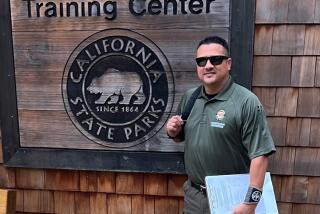Workers Trying to Prove Job Bias Win More Leeway From Justices
WASHINGTON -- The Supreme Court made it easier Monday for workers to win discrimination claims against their employers, siding with a female forklift driver at a Las Vegas warehouse who was called a trailblazer by some and a troublemaker by others.
In a rare victory for job bias plaintiffs, the high court -- by a 9-0 vote -- said workers who sue do not need a “smoking gun” memo or other “direct evidence” of discrimination.
Instead, they can take their cases to a jury as long as they can show some evidence that illegal bias was “a motivating factor” in their being fired or not hired -- even if it was not the only factor.
In 1994, Catharina Costa was the only woman working on the forklifts in the warehouse at Caesars Palace. She was fired after getting into a shoving match with a male co-worker.
Costa said she had been subjected to a series of sexist and vulgar comments, as well as unfair treatment. For example, she said, she was penalized for reporting to work one minute late for the 6 a.m. shift, while male co-workers who were an hour late were not penalized.
Her supervisors said they fired Costa because she was rude and belligerent.
The circumstances offered a classic example of what lawyers call a “mixed motive” case. About 20,000 discrimination claims are filed each year in federal court, and Monday’s ruling clarifies a subtle point that could determine the outcome of many of these cases.
Over the last decade, many judges have thrown out allegations of job bias before a jury trial if the fired worker did not have “direct evidence” of discrimination.
These judges relied on a 1989 opinion written by Justice Sandra Day O’Connor.
But on Monday, the justices said the lower court judges were wrong.
In 1991, Congress changed the law to make it easier for discrimination victims to pursue their cases and allowed for claims based on weaker, circumstantial evidence of bias.
Judges should rely on the 1991 law, not O’Connor’s earlier opinion, the justices said in Desert Palace Inc. vs. Costa.
Robert N. Peccole, a Las Vegas lawyer who represented the fired forklift driver, said he was delighted with the ruling.
“This says you have a right to present all your evidence to the jury, whether it is circumstantial or direct evidence,” Peccole said. A jury in Las Vegas ruled for Costa and said Caesars Palace owed her $364,000 in damages. She has since gone to work as a forklift driver at the Convention Center, Peccole said. She could not be reached for comment Monday. Last year, the U.S. 9th Circuit Court of Appeals upheld the verdict on a 7-4 vote.
But in most other regions, judges have said that plaintiffs such as Costa must have clearer evidence of race or sex bias before taking their claims to a jury.
“Most of these are mixed motive cases,” said Michael Subit, a Seattle lawyer with the Lawyers Committee for Civil Rights Under Law, a nonpartisan organization that provides legal services to address racial discrimination.
“But the trend has been for judges to throw out these cases and say the plaintiff didn’t have direct evidence” of discrimination, he said.
Stephen Bokat, general counsel for the U.S. Chamber of Commerce, called the ruling “a real disappointment for business.”
The key issue for most employers is whether the lawsuit goes to a jury, he said.
“Employers will try to get a case dismissed by a judge by arguing she doesn’t enough have evidence of discrimination. If it is not resolved by the judge, most of the time they [employers] will settle,” Bokat said.
In 1991, Congress passed the Civil Rights Restoration Act with the aim of overturning several high court rulings that made it harder for discrimination victims to win their cases.
In Monday’s opinion, Justice Clarence Thomas said Congress’ wording of federal law, not the justices’ earlier interpretations, controls the outcome.
More to Read
Inside the business of entertainment
The Wide Shot brings you news, analysis and insights on everything from streaming wars to production — and what it all means for the future.
You may occasionally receive promotional content from the Los Angeles Times.











